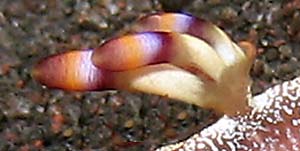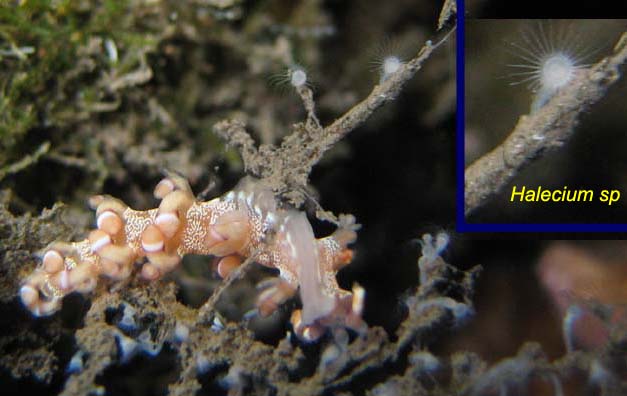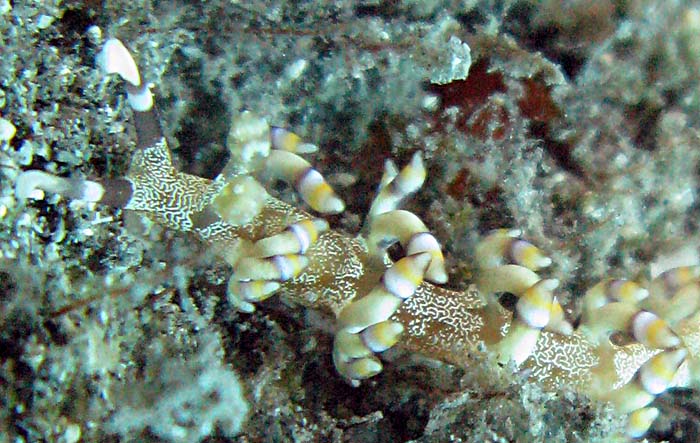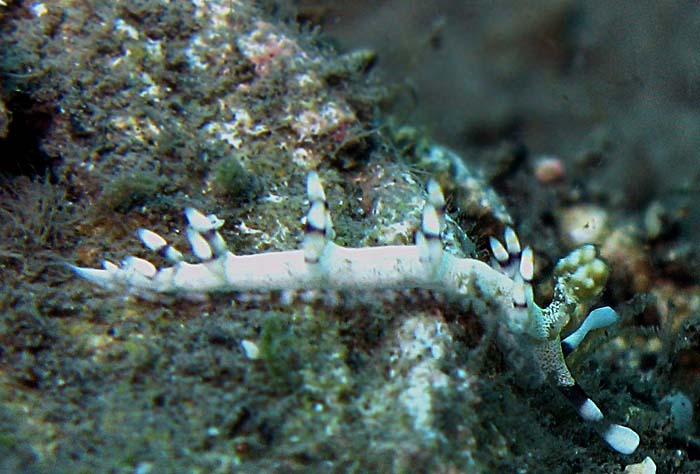This species has been observed on Reunion, Mayotte and Madagascar Islands
Species characteristics : Most of the body is translucent white, adorned with a dense, lacy reticulum of opaque white lines. |

|
|
| Showing species characteristics... | Photo Florence Trentin Reunion, "La Barge " Saint Paul, 25 m, crawling on the sand during the night, 2 February 2007. Size : 25-30 mm |
|
Remarks :
Identification confirmed by Terry Gosliner, Hsini Lin and Bill Rudman
Synonymous : (according Worms)
- Flabellina riwo Gosliner & Willan, 1991
|
  |
 |
We also find, like other specimens (see Bill Rudman seaslug site), a yellow orange mark at least on the dorsal surface of the paddle-shaped tip to the oral tentacles.
|
Bibliographic data :
The epithet "riwo" refers to Riwo village, approximately 15 km north of Madang, Papua New Guinea, where this species was first found.
The basal and cylindrical portion of the rhinophores is translucent white; the bulbous, lamellate (containing 16-22 densely crowded lamellae) portion is dull peach to light orange and the apex is translucent white.
The oral tentacles are long and opaque white for most of their length, but possess a translucent basal portion near their junction with the head. The bases of the tentacles are thin whereas the distal third is markedly laterally compressed and paddle-shaped.
But in our specimen, we have a yellow orange mark at least on the dorsal surface of the paddle-shaped tip to the oral tentacles.
The anterior foot corners are short, tentacular, and recurved.
The cerata are arranged in 3-6 pedunculate clusters per side of the body. The ceratal formula varies considerably from small to large individuals, each peduncle contains a single row of 1 to 4 cerata.
The base of the cerata may be either translucent white or obscured by opaque white pigment. When translucent, the cream, lobate digestive gland is visible. The apical portions of the cerata are covered with opaque white. Near the middle or in the distal third of each ceras is a broad purple ring.
But in our specimen, we find a apical purple extra band with the classsical orange ans purple inner bands.
The gonopore is located ventrally to the precardiac ceratal peduncle, on the right side of the body.
The anus is situated between the precardiac and first postcardiac rows, generally closer to the more posterior peduncle.
Similar species
Samla bilas, Samla bicolor and Samla riwo are three species of the genus with these chracteristic "paddle-shaped" oral tentacles. The only species with the white reticulate pattern on the body and a purple band on the cerata is Samla riwo
References :
Bill Rudman Seaslug site : Sea Slug Forum : Flabellina riwo
Publications :
Gosliner,T.M. & Willan,R.C. (1991) Review of the Flabellinidae (Nudibranchia: Aeolidacea) from the tropical Indo-Pacific, with the descriptions of five new species. The Veliger, 34(2) : 97-133.
Korshunova, T.; Martynov, A.; Bakken, T.; Evertsen, J.; Fletcher, K.; Mudianta, W.; Saito, H.; Lundin, K.; Schrödl, M.; Picton, B. (2017). Polyphyly of the traditional family Flabellinidae affects a major group of Nudibranchia: aeolidacean taxonomic reassessment with descriptions of several new families, genera, and species (Mollusca, Gastropoda). ZooKeys. 717: 1-139
Other photos of Samla riwo :
Florence Trentin Reunion, "La Barge " Saint Paul, 25 m, crawling on the sand during the night, 2 February 2007. Size : 25-30 mm A very caracteristic colored pattern... ...with the anterior foot corners short, tentacular, and recurved.
|
 |
 |
Sophie Darnis Reunion, "La Barge" St Paul , 23 m, 24 May 2008, size 20 mm, According Nicole Gravier Bonnet, the hydroid observed belongs to the family Haleciidae provisionally identified as "Halecium sp." Source of food for this species ??? see also Erwan Meyer specimen  |
Sully Bachel Reunion, Cap la Houssaye, two specimens in a small area (1 m2), 10 m, 22 November 2008, size : 15 mm. |
 |
 |
Sully Bachel Reunion, "Cap la Houssaye" Saint Paul, 9m, 13 December 2008, size 20 mm The distal portion have a purple ring and sometimes a yellow band above the purple one. This specimen corresponded, to the original description of Gosliner & Willan |
Monika Bachel Réunion, La Possession, 7 m, 28 December 2008, size 12 to 15 mm. 5 specimens observed during this dive The distal portion have a dark purple ring and sometimes a orange/yellow band above the purple one. |  |
 |
Matthias Deuss Mayotte, 21 December 2011
The distal portion have a dark purple ring and sometimes a orange/yellow band above the purple one. |
Alain-Benoît Rassat Madagascar, Nosy Bé, Plateau des arches 14m, 31 October 2015, size : 30 mm
|
.jpg) |
More photos from Indian Ocean
Reunion, two Samla riwo on a hydroid, at Saint Paul, by Erwan Meyer